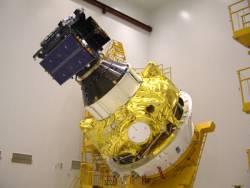 GIOVE-A mated with Fregat launcher upper stage. ESA photo
GIOVE-A mated with Fregat launcher upper stage. ESA photoAn experimental GPS receiver, built by Surrey Satellite Technology Limited (SSTL), has successfully achieved a GPS position fix at a 23,300-kilometer altitude — the first position fix above the GPS constellation on a civilian satellite, according to the company.
SSTL’s SGR-GEO receiver is collecting data that could help the company to develop a receiver to navigate spacecraft in geostationary Earth orbit (GEO) or even in deep space.
An experimental GPS receiver, built by Surrey Satellite Technology Limited (SSTL), has successfully achieved a GPS position fix at a 23,300-kilometer altitude — the first position fix above the GPS constellation on a civilian satellite, according to the company.
SSTL’s SGR-GEO receiver is collecting data that could help the company to develop a receiver to navigate spacecraft in geostationary Earth orbit (GEO) or even in deep space.
GPS is routinely used on low Earth orbit (LEO) satellites to provide the orbital position and offer a source of time to the satellite. However, spacecraft in orbits higher than 20,000 kilometers, the space occupied by the GPS constellation, can only receive a few of the signals that “spill over” around the limbs (outer edges) of the Earth. Consequently, the signals received at higher altitudes are much weaker and a position fix cannot always be secured.
With the support of the European Space Agency (ESA) and the agency’s fourth Advanced Research in Telecommunications Systems (ARTES 4) program, SSTL included the SGR-GEO receiver on the GIOVE-A satellite to demonstrate that a receiver could achieve a position fix from a higher orbit.
The 24-channel, single-frequency (L1) SGR-GEO is adapted from SSTL’s SGR (Space GPS Receiver) product line and incorporates a high-gain antenna and a precise oven-controlled clock. It will demonstrate special algorithms to allow reception of weak signals and an orbit estimator intended to allow a near continuous position fix throughout orbit.
Martin Unwin, principal GNSS engineer at SSTL, says: “The results from the SGR-GEO receiver are really encouraging. We’re getting higher signal strengths than anticipated and also acquiring side lobes from the GPS transmit antennas, which improves the availability of the useable signals for navigation. With the success of the SGR-GEO receiver, GPS, in combination with Galileo and GLONASS could soon be helping navigate spacecraft much further away from Earth.”
The experimental GPS receiver onboard the GIOVE-A (Galileo In-Orbit Validation Element-A) satellite has been inactive for six years while the spacecraft has been used for its primary purpose of transmitting prototype Galileo signals. In August 2009, the GIOVE-A was moved into a graveyard orbit about 100 kilometers above its normal 23,22-kilometer orbit to make way for the Galileo validation satellites.
GIOVE-A’s retirement by ESA in June 2012 has allowed the commissioning of the high-altitude positioning experiment and is now providing valuable data to SSTL and ESA in support of the future use of spaceborne GNSS receivers at GEO altitudes.
Engineers at SSTL will continue operations, testing out, tuning and improving the receiver software onboard GIOVE-A to achieve the best possible performance.




 before launch.jpg)
